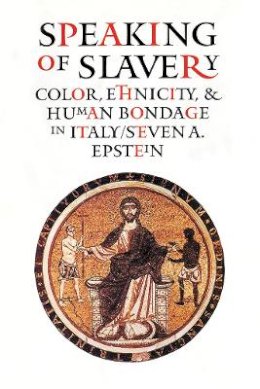
Speaking of Slavery: Color, Ethnicity, and Human Bondage in Italy
Steven A. Epstein
In this highly original work, Steven A. Epstein shows that the ways Italians employ words and think about race and labor are profoundly affected by the language used in medieval Italy to sustain a system of slavery. The author's findings about the surprising persistence of the "language of slavery" demonstrate the difficulty of escaping the legacy of a shameful past.
For Epstein, language is crucial to understanding slavery, for it preserves the hidden conditions of that institution. He begins his book by discussing the words used to conduct and describe slavery in Italy, from pertinent definitions given in early dictionaries, to the naming of slaves by their masters, to the ways in which bondage has been depicted by Italian writers from Dante to Primo Levi and Antonio Gramsci. Epstein then probes Italian legal history, tracing the evolution of contracts for buying, selling, renting, and freeing people. Next he considers the behaviors of slaves and slave owners as a means of exploring how concepts of liberty and morality changed over time. He concludes by analyzing the language of the market, where medieval Italians used words to fix the prices of people they bought and sold.
The first history of slavery in Italy ever published, Epstein's work has important implications for other societies, particularly America's. "For too long," Epstein notes, "Americans have studied their own slavery as it if were the only one ever to have existed, as if it were the archetype of all others." His book allows citizens of the United States and other former slave-holding nations a richer understanding of their past and present.
Product Details
About Steven A. Epstein
Reviews for Speaking of Slavery: Color, Ethnicity, and Human Bondage in Italy
Susan Mosher Stuard, Haverford College
Journal of Interdisciplinary History
Speaking of Slavery argues that Italian words specifically, and Italy's spoken culture generally, supported the owning and exploiting of humans, thus mainstreaming ideas about cultural superiority and inferiority that are still evident in Italian nomenclature today.... Epstein's study is successful on two fronts. First, he successfully challenges the alienation of discussions of New World slavery to the American context; moreover, he demonstrates that the attitudes of explorers like Christopher Columbus cannot be separated from preexisting slave traditions and language traditions. While the international slave market lost its stronghold long ago, the language established to support it still shapes ideas about race. In the end, the relationship between early Italian slavery and Italian ideas about ethnicity is still evident in the language used to talk about color and race, specifically the language reserved for immigrant laborers and ethnic minorities living in Italy today.
Audrey Kerr, Southern Connecticut University
Sixteenth Century Journal
Scholars with specialisms outside Italy will find a great deal of interest in this book and many intriguing parallels with systems of slavery elsewhere.... Epstein's persuasive notion of the corrupting and normalizing language of medieval slavery will effect a permanent change in the way in which Italian slavery will be approached in the future. His pioneering, well written and constructed study is very timely, and it is to be hope that it will provide a lead for other much needed investigations of the culture of Italian slavery, both historical and interdisciplinary.
Kate Lowe
Slavery and Abolition
Steven Epstein's study of slavery in medieval Italy focuses on language, the ways people talked or wrote about slaves in a variety of contexts and the ways slaves talked about themselves. He makes it clear that slavery's significance in Italian history is more cultural than economic; although he does discuss the kinds of work that slaves did, he is more concerned with the intellectual and social implications of markets than with quantifying the contributions of slaves to production.... In the later Middle Ages women slaves outnumbered men slaves, while among free servants men were the minority. Epstein implies that the feminization of (free) domestic service in sixteenth-century Venice may be a result of the decline of slavery and the replacement of female domestic slaves by free female servants.... A final contribution of Epstein's work is to set slavery in the context of servanthood and poverty. Servants and poor laborers were not legally property, but their lives might be in effect quite similar to those of slaves, and the kind of language used about them could be similar as well.
Ruth Mazo Karras, University of Minnesota
Speculum
The heart of the book examines the language used in many kinds of medieval documents dealing with slavery... Many interesting individual stories and insights....
Choice
